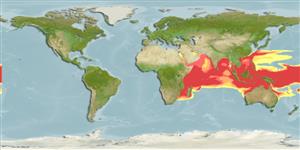Common names from other countries
>
Beloniformes (Needle fishes) >
Exocoetidae (Flyingfishes)
Etymology: Parexocoetus: Greek, para in the side of + Greek, exos = outside + Greek, koite = hole (Ref. 45335).
More on author: Valenciennes.
Environment: milieu / climate zone / depth range / distribution range
Ecologia
marino; oceanodromo (Ref. 51243); distribuzione batimetrica 0 - 20 m. Tropical; 30°N - 23°S, 20°E - 178°W
Indo-Pacific: widespread from East Africa, including the Red Sea and the Gulf, to southern Japan, Marshall Islands, Fiji, the Arafura Sea (Ref. 9819) and Queensland, Australia. Migrated to eastern Mediterranean through the Suez Canal (Ref. 6523). Presence in Somalia to be confirmed (Ref. 30573). Records from the Atlantic (as Parexocoetus mento atlanticus) are in error.
Size / Peso / Age
Maturity: Lm ? range ? - 13 cm
Max length : 11.0 cm SL maschio/sesso non determinato; (Ref. 2797)
Spine dorsali (totale) : 0; Raggi dorsali molli (totale) : 9 - 12; Spine anali: 0; Raggi anali molli: 10 - 12. Dorsal fin mostly blackish; pectorals and caudal greyish, other fins transparent (Ref. 2797).
Found in near-shore surface waters, never spread to open sea (Ref. 9839). Capable of leaping out of the water and gliding above the surface (Ref. 30573).
Most die after a single spawning (Ref. 205).
Parin, N.V., 1996. On the species composition of flying fishes (Exocoetidae) in the West-Central part of tropical Pacific. J. Ichthyol. 36(5):357-364. (Ref. 27313)
IUCN Red List Status (Ref. 130435)
CITES (Ref. 128078)
Not Evaluated
Threat to humans
Harmless
Human uses
Pesca: scarso interesse commerciale
Strumenti
Special reports
Download XML
Fonti Internet
Estimates based on models
Preferred temperature (Ref.
115969): 25.9 - 29.1, mean 28.5 (based on 4012 cells).
Phylogenetic diversity index (Ref.
82804): PD
50 = 0.6250 [Uniqueness, from 0.5 = low to 2.0 = high].
Bayesian length-weight: a=0.00646 (0.00292 - 0.01429), b=3.04 (2.84 - 3.24), in cm Total Length, based on LWR estimates for this (Sub)family-body shape (Ref.
93245).
Trophic level (Ref.
69278): 3.3 ±0.4 se; based on size and trophs of closest relatives
Resilienza (Ref.
120179): Alto, tempo minimo di raddoppiamento della popolazione meno di 15 mesi (Preliminary K or Fecundity.).
Fishing Vulnerability (Ref.
59153): Low vulnerability (10 of 100).
